
With three cruises canceled and borders closed, Brian and I needed a mini-getaway once Covid-19 restrictions were lifted. So, we took a three-day trip to Whistler, just a two-hour drive from home. While we planned an itinerary, finding things open was hit and miss.
So, we ended up flying by the seat of our pants. We planned a few hikes, mostly to waterfalls such as Shannon, Brandywine, and Nairn Falls. But, one of our most enjoyable walks was the Whistler train wreck hike.
Brian and I love to get off the beaten path and visit some unusual places in and around Vancouver. So, we couldn’t resist visiting this train wreck. A train wreck might not seem like a can’t-miss attraction, but this one was hidden in an old-growth forest, with no train tracks in sight.
The mystery behind the train wreck was unsolved for many years until recently. While the train crash took place over sixty years ago, the rusty wreckage has become a popular place of interest in Whistler.
Getting To The Train Wreck Trail
While I love my trusty GPS, sometimes, it steers me astray. This was the case of trying to access the parking lot for the start of the trail. The GPS wanted me to pull over on the Sea to Sky Highway (highway 99) because it indicated the train wreck was nearby.
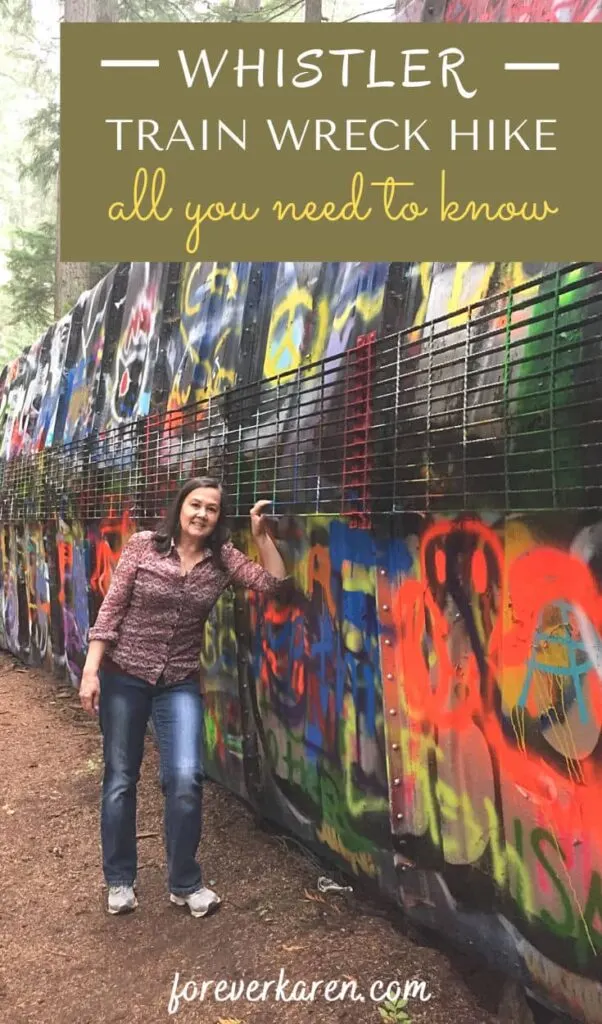
However, to get to the parking lot from Highway 99, turn south onto Cheakamus Lakes Road. At the fork, continue right onto Legacy Way. Turn right at Jane Lakes Road, which turns into Whistler Quarry Road.
The dirt parking lot is on the left-hand side. The signage is small and easy to miss. If you end up in the mining area, you’ve gone too far.
The Train Wreck Hike
From the parking lot, cross the road for the start of the 2 km round-trip trail. The estimated hike is one hour, and an easy hike to do in Whistler. However, we took much longer as we explored the wreckage and took lots of photos.
The well-liked Whistler train wreck hike is relatively flat, well-marked, and easy compared to the Grouse Grind in Vancouver and our local hike, the Crunch in Coquitlam.
While the train wreck hike is open all year round, it will require snowshoes in the winter months. The trail is suitable for all ages and dog-friendly, but a newly erect sign reminded me, that we were in bear country.

One of the best ways to avoid bears is to make noise, so Brian and I started our hike singing our hearts out. Alternatively, you can carry a bear bell.
Walking the trail that meandered through the cedar and fir trees, we enjoyed picturesque views of the forest and the peacefulness of being outside the city. Towards the end of the trail, a fork in the path gives two options to get to the river.

The right-hand path is the easy way down and the more challenging descent to the left. We chose the easy route, which took up down to a boardwalk that led up to a newly constructed suspension bridge.
The Suspension Bridge
In the past, hikers were using the nearby railroad tracks to access the train wreck. The active tracks are private property, so it’s not only dangerous to walk them, but illegal too.
Due to the overwhelming number of hikers walking the tracks, the city built a suspension bridge in 2016. The bridge provided easier access to the train wreck and prevented accidents on the tracks.
The bridge is a beautiful piece of art and not your ordinary BC suspension bridge. The unique anchors resemble locomotive wheels, while the cedar decking mimics railway ties.
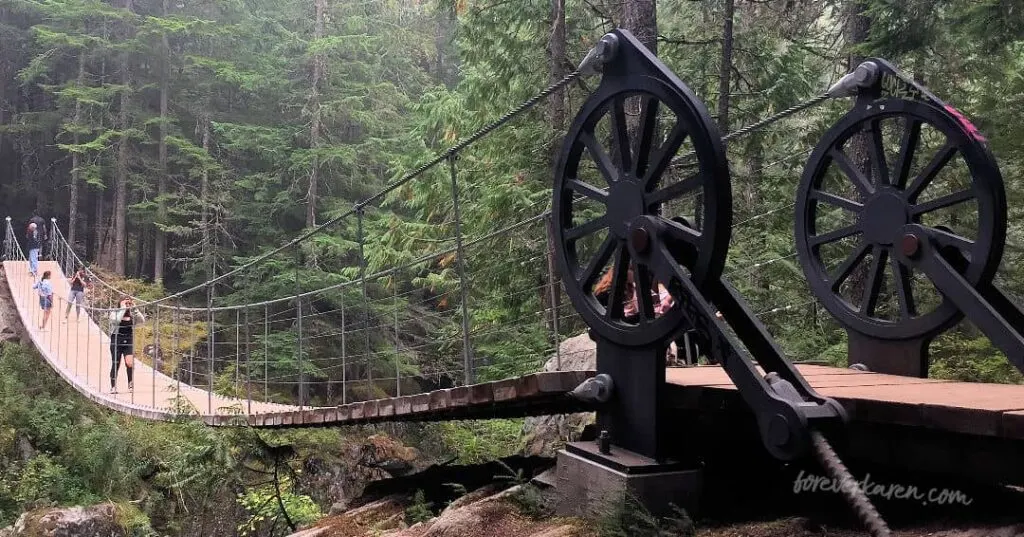
The bridge connects the trails on the east side of the Cheakamus River to those on the west. The train wreck trail is part of the Sea to Sky trail, which runs from Whistler to Squamish.
Before crossing the suspension bridge, we sat on a wooden bench admiring the river’s rushing waters below. A nearby plaque tells the first part of the train wreck story.
Whistler Train Wreck History
The plaque states the accident took place on August 11th, 1956. While train accidents are a rare occurrence today, it wasn’t so all those years ago. Initially, the train started in Lillooet, 130 km (80 miles) north of Whistler.
Bound for Vancouver and running behind schedule, the conductor tried to make up time by travelling faster. Travelling at double the recommended speed, one of the engines jumped the track at a narrow section of a sharp curve. In all, twelve boxcars derailed and blocked the tracks for days.
Walking across the suspension bridge and up a small hill, we came to the end of the Whistler train wreck hike, and the wreckage came into view. There were three boxcars to my right and the other four to my left. A second plaque tells the story of the cleanup.
While some of the cars were salvageable, seven were too damaged to save. Those remaining seven were stripped of useful materials, dragged away from the tracks, and left to become part of nature.
Train Cars Became A Living Canvas
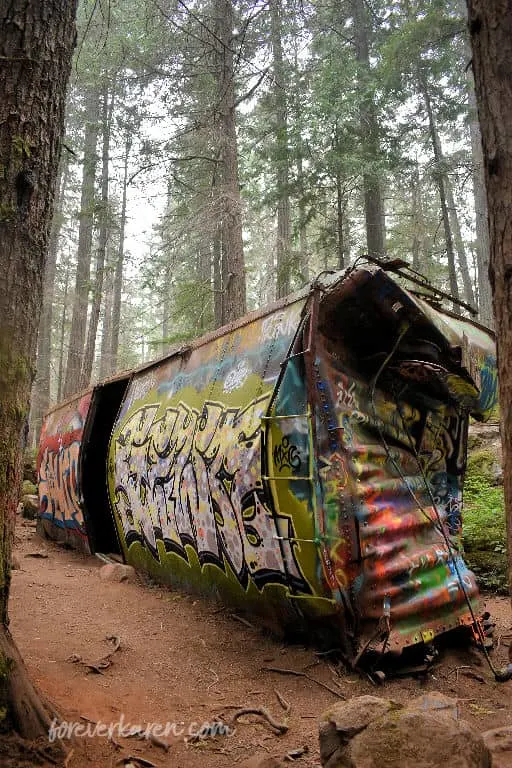
Over sixty years of weather, the rusted wreckage has become a living canvas, forever changing. Time has allowed the forest to grow around the decaying boxcars, and they seem out of place. The area has become a haven for mountain bikers, photographers, hikers, and graffiti artists throughout the years.
The graffiti artists have left their mark with colourful murals, both inside and out. Like every graffiti canvas, the pictures are always changing as visitors bring their spray cans to leave their mark. Some have professed their love with hearts and names, adding a touch of romance to their Whistler hike.
In one boxcar, I could still smell the powerful odor of paint as a young couple left. Their chosen colour was purple.
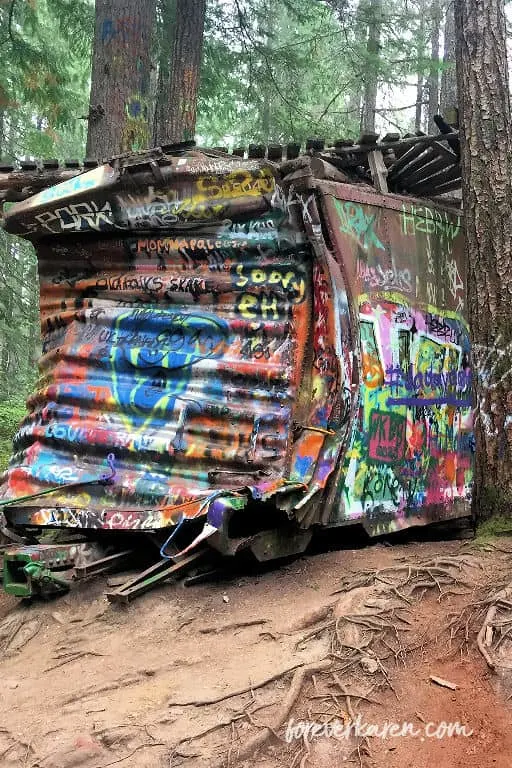
The ladders on the boxcars allow visitors to climb on the rusted shells. While I did not venture on top of the boxcars, Brian said tourists had spray-painted them too. Unfortunately, some used their pigment on the municipal signs, which were no longer legible.
Most visitors miss the last two boxcars, buried deeply in the trees. Maybe, because of their distance from the others. One car lay on its side, almost crushed from the crash’s impact, while the others remain mostly intact. Two boxcars remained joined with one hanging over the Cheakamus River below.
I found unexpected beauty in this outdoor art gallery as the urban melded so seamlessly with nature. While visitors have covered the original murals with new pigments, this colourful train graveyard captivated me.
Happy travels ~ Karen
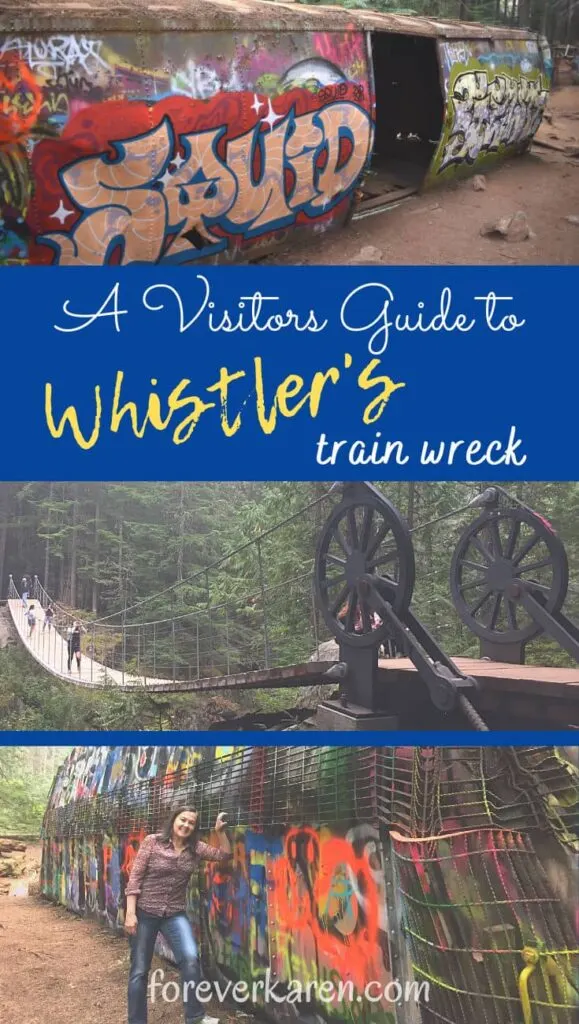

Ken Johnstone
Saturday 13th of May 2023
Great info. Love the story.